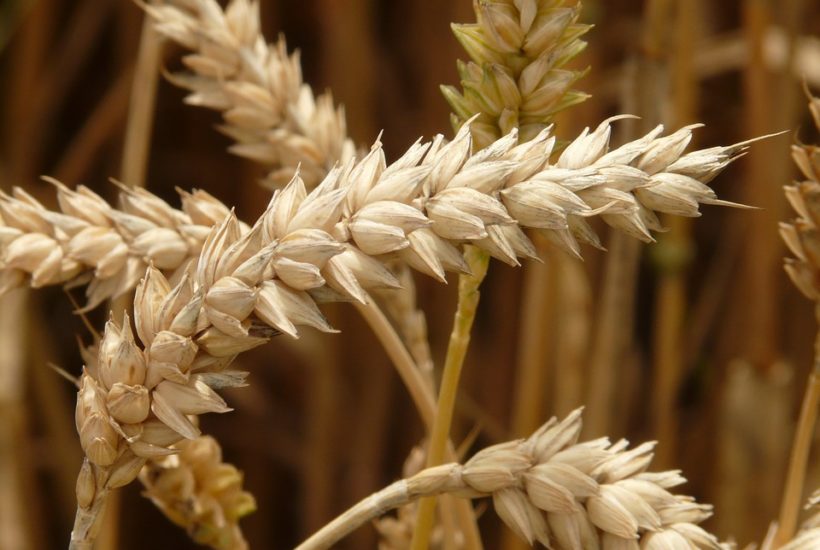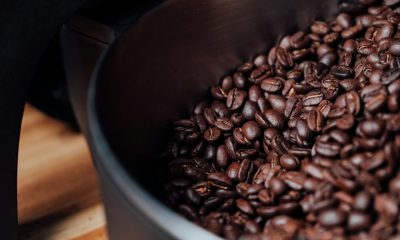Featured
Wheat markets, cocoa futures close lower
Cocoa futures closed lower. Some of the selling in New York was currency-related as the US Dollar has held very strong. The weather in Ivory Coast has been drier than normal for the last couple of weeks and there is some talk that production of the next main crop could be hurt. Demand in Asia has been growing and Indonesia has been eager to be the primary source of cocoa.

Wheat
Wheat markets were lower again last week as the markets prepared for the next round of USDA US and world production and supply and demand estimates that will be released today. Futures have also been under pressure as the market searches for demand. Ideas are that feed demand for Winter Wheat has been strong in the Great Plains, but export demand has been harder to find. Export sales reports so far have been rather routine and USDA implied improved demand due to less world production in its updates last month. USDA will issue new production reports today. Some changes are possible for Spring Wheat due to good weather in most areas but dry weather in areas near the Canadian border. Some adjustments are possible for White Wheat as well.
Most of the Winter Wheat harvest is over so the data from the harvest should be available for SRW and HRW estimates. There could be some stronger estimates for domestic feed demand, but USDA made many adjustments to the demand side of the ledger for Wheat last month and might not change much this month. The weather remains dry in much of the Midwest and Great Plains, but some rains have been noted in the Northern Plains to slow harvest activity there. USDA showed that the Spring Wheat harvest was just getting started in its reports last week and should show moderate progress with the Spring Wheat harvest this week.
Corn
Corn closed lower on ideas of little demand and improving crop conditions. Traders were also liquidating positions before the USDA reports today. USDA will issue its first state by state production estimates and also updated acreage estimates. Corn planted area is likely to be less in the reports that will be released later today. Yield estimates are just a guess right now as the crop in many areas is not mature enough to make many judgments. We took a one-day crop tour of central Illinois over the past weekend. Areas west of Interstate 55 and north of Interstate 80 showed a lot of prevent-plant area that was still black soil or planted to a cover crop. The area was significant as it seemed that one third to one half of this region had not been planted.
Significant prevent-plant area was noted near Pontiac and east of Bloomington as well. Prevent planted area was also noted south of Kankakee. Most of the crop is just silking or in blister now. Only a few fields were in milk or dough or starting to dent. It is normal for the crop to be at least in milk and usually in dough by this date, but this was noted only south and east of Bloomington this year. Calculations for yield estimates were just about impossible to make. The crop needs warm and wet growing conditions from now on this year to reach best yield potential, Forecasts, for now, call for relatively cool and dry conditions, so the crop is likely to remain stressed and progress will likely remain slower than normal.
Soybeans and soybean meal
Soybeans and soybean meal closed a little lower last week in anticipation of the USDA crop reports that will be released later today. USDA plans to include a state by state breakdown of production but will have little information to make good estimates. US planted area to Soybeans is expected to increase as farmers switched to Soybeans from Corn in some cases as planting got very delayed. Some producers probably planted Soybeans as a cover crop on prevent-plant acreage as well. Prevent plant acreage was significant on our weekend tour of Central Illinois with the most noted north of Morris and west of Interstate 55.
Significant prevent-plant area was noted near Pontiac and west of Bloomington. The rest of the crop was late and just flowering or setting pods in the most advanced cases. Soybeans in the western part of the trip tended to be very small and ranged anywhere from half a foot to a foot and a half tall. Crops were most advanced south and east of Bloomington and the crops in these areas were in the best conditions. Many areas were showing stress and needed a good rain. There is not much rain in the forecast so crops will most likely continue to be stressed even though it is not really hot.
Rice
Rice was lower last week trends are down in this market. The trade will be very interested in the USD reports that will be released later today and will look closest at the acreage estimates. Ideas are that USDA has been too high in its planted area estimates due to all of the rain at planting time. This data will be released in conjunction with the production reports. Yield reports from southern Louisiana and Texas are not bad but are not as strong as they could be, It is possible that USD will trim its yield estimates in the reports today. production could be less but USDA need not make any real changes to the demand side of the ledger after making some positive demand adjustments last month. USDA noted stronger than expected domestic demand last month and export demand has been good all year. All this could imply that the Rice market makes an early harvest low this year and turns higher in the short term.
Palm oil and vegetable oils
World vegetable oils markets were higher last week. The weekly charts for all three markets show that trends are turning up. Palm Oil was in a short term and short-covering rally last week on ideas that demand could improve and as the US Dollar moved higher. Production ideas remain high for Palm Oil with both Malaysia and Indonesia talking about big production. The export pace from Malaysia has improved, since more was exported in July than in June, but ideas are that the production is strong enough so that the improved demand will not do that much to create a tight stocks scenario. The weather has featured some rains but also dry periods and is being called good for Palm Oil production.
Soybean Oil was higher. The US is facing increased competition for sales now from South America, and mostly from Argentina. Argentina has traditionally been the major source for Soybean Oil in the world market as it prefers to use other oils at home for its cooking needs. The weather in the US has been uneven in the US after a very delayed start to the growing season. There are valid questions on how many Soybeans will be produced and the amount of Soybean Oil the US will have to sell. US Soybeans will need a very late end to the growing season this year to have all that much in the way of Soybean Oil to offer into the world market. Canola was higher last week on uneven weather conditions. Parts of the Prairies remain too dry although rains have increased lately. The provincial reports have noted the uneven conditions as the growing conditions have been rated less than 50 percent good to excellent. Production ideas are starting to slide again and are now around 18 million tons after the first reports indicated that 20 million tons or more could be produced.
Cotton
Cotton was lower for the week and weekly charts show that futures made new lows for the move. The weather has been considered good for Cotton production in the US. It has been warm but there have been showers to support good development. The main exception has been in the Texas Panhandle where it has been hot and dry. Conditions in the Delta and Southeast have been strong and have improved over the last few weeks. Crop development remains on about an average pace and bolls should start to form soon. Demand remains a big problem for Cotton. World demand has been less this year as China has not been buying.
World prices have been lower as a result. The situation is bad enough that Indian spinners have been cutting back on operations. USDA will note less demand for US Cotton as well, primarily due to the trade disputes the US government has started against China and other major world importers. US production prospects have improved after a rough start to the season and the trade expects roughly unchanged production estimates from USDA later today.
Frozen concentrated orange juice and citrus
FCOJ was a little lower last week and could move lower again this week. The weather in Florida remained tranquil as the state has seen frequent showers and storms that have greatly reduced irrigation needs. There are no hurricanes likely to hit the state this week, but the tropics are getting more active. A couple of waves have formed that could bring some tropical rains but no harmful weather. Futures appear poised to move back to or below 90.00 seen earlier in the year. Speculators have been buying in anticipation of the hurricane season, but there are no storms on the horizon this early in the season.
The state has only seen an increase in showers and storms that have been beneficial for crops. Trends are sideways to down on the daily charts and weekly charts as the market looks at a big orange crop and weak demand for FCOJ. USDA kept its production estimates above 70 million boxes in the production reports. Inventories in Florida are still 15 percent above a year ago. Fruit for the next crop is developing as big as baseballs. Crop conditions are called good. Mostly good conditions are reported in Brazil.
Coffee
Futures closed lower in both markets on ideas that the export pace from Brazil remains strong and as roaster buying remains generally hard to find. The new harvest is now past 8-0 percent complete and is starting to become available so the country should be able to keep up a strong export pace for at least the next few months. The Brazil harvest is moving along and producers are trying to store the crop due to the current low prices. Reports indicate that the yields are not really strong and that the quality of the crop is poor due to extreme weather seen early in the growing season.
Vietnam is also reporting lower yields for the current crop as the weather was not good for flowering earlier in the year. There have been some hot and dry spells that have hurt yield and quality for these crops as well, but showers are reported in the Central Highlands now and ideas are that conditions and production potential have improved. Central America has Coffee on offer, but bid prices from buyers have been very low.
Sugar
Futures closed lower for the week in both markets. Support came from ABIOVE who reported a slower crush of Sugarcane in its latest report a couple of weeks ago and still strong processing of the cane into Ethanol. The recent freeze may have hurt some of the cane. World supplies still appear ample for the demand potential. Reports from India indicate that the country still has a large surplus of White Sugar that probably must be exported. India is reporting below-normal monsoon rains, but the rains have been much better lately. There are concerns that the Indian monsoon will not be strong this year and that Sugarcane production could be hurt.
Processing of Sugarcane in Brazil is slower and the pace of the crush is behind last year. Mills are refining mostly for ethanol right now as has been the case all season. The fundamentals still suggest big supplies, and the weather in Brazil is good enough and India has improved to support some of the big production ideas. Very good conditions are reported in Thailand.
Cocoa
Futures closed lower. Some of the selling in New York was currency-related as the US Dollar has held very strong. The uneven weather in West Africa is still a feature. The weather in Ivory Coast has been drier than normal for the last couple of weeks and there is some talk that production of the next main crop could be hurt. Some showers are returning to West Africa now to help relieve stress on trees. Ideas are that the next crop will be good. The harvest will start in the Fall.
Growing and harvesting conditions in Asia are also reported to be good. The harvest is ongoing amid showers, but good progress in the harvest is expected at this time. More and more Asian Cocoa has been staying at home and processed in Indonesia for export in the region. Demand in Asia has been growing and Indonesia has been eager to be the primary source of Cocoa.
—
DISCLAIMER: This article expresses my own ideas and opinions. Any information I have shared are from sources that I believe to be reliable and accurate. I did not receive any financial compensation for writing this post, nor do I own any shares in any company I’ve mentioned. I encourage any reader to do their own diligent research first before making any investment decisions.

-

 Crowdfunding2 weeks ago
Crowdfunding2 weeks agoFlower Burger Launches Crowdfunding to Fuel Growth in Booming Plant-Based Market
-

 Business3 days ago
Business3 days agoTopRanked.io Weekly Affiliate Digest: What’s Hot in Affiliate Marketing [1xBet + FIFA World Cup]
-

 Business1 week ago
Business1 week agoThe TopRanked.io Weekly Digest: What’s Hot in Affiliate Marketing [K4G Affiliates Review]
-

 Crypto5 days ago
Crypto5 days agoTether Targets $500 Billion Valuation in Landmark Funding Push
























